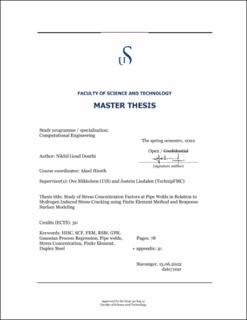| dc.description.abstract | Duplex stainless steels, which are extensively used in the energy industry for subsea piping, have seen some significant failures, especially at the weld locations of cathodic protected piping components due to hydrogen induced stress cracking (HISC). This is because of the high stress concentrations at the weld hotspots. Estimating these stress concentration factors is an area of interest in the industry for studying and qualifying the welds for HISC acceptance as per the industry recommended practice, DNVGL-RP-F112.
In this thesis study, stress concentration factors at various pipe welds of different sizes and geometric parameters are estimated using the finite element method (FEM) and response surface modeling (RSM). The critical weld geometric parameters and fabrication tolerances that have a significant influence on the stress concentration are identified and studied how they affect the stress distribution in the model. The additional stress concentration induced by the secondary bending moments in the model due to centerline misalignment between the components is estimated using the 3D finite element model of the weld. The analysis models are simplified to axisymmetric models wherever possible by making reasonable approximations with the available FEM data to save computational time and expense.
The stress magnification factors estimated at some weld geometries are compared with the values calculated using the formulae from DNVGL-RP-C203, wherever applicable, and they are in line with the analytical calculations. A fillet weld between doubler plate and pipe, with high stress concentrations that couldn’t meet the linear elastic assessment criteria, is checked with the actual loads from project pipe stress analysis and qualified using non-linear assessment.
Gaussian process regression modeling is used to predict the stress concentration factors at different combinations of geometric parameters based on the available FEM data and is found to be reasonably accurate when tested with random values from the estimated FEM data. It was found that the local surface penalty/ magnification factors are almost the same for different header sizes checked, provided they are of the same thickness and weld parameters. The estimated local surface penalty/ magnification factors for different combinations of wall thickness and toe fillet radius are calculated and plotted. | |
